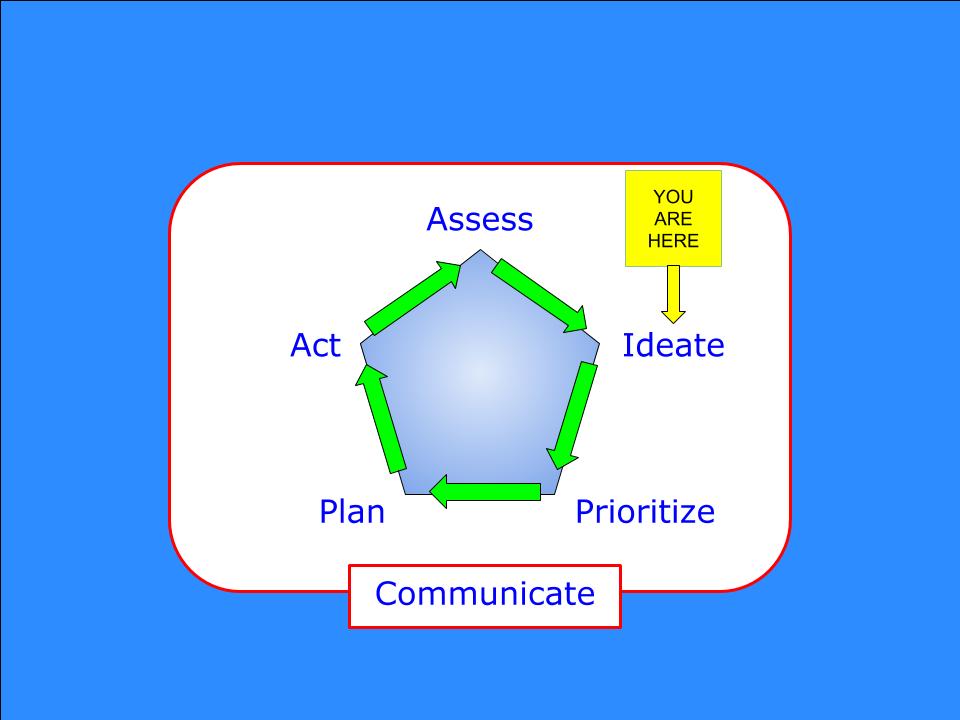Introduction
In the last article, I described the first phase in the planning cycle, Assess, which focuses on identifying a problem or opportunity (the “Assessment Topic”) and evaluates your current state using the technique of SWOT analysis. In this article, we’re going to look at the next phase in the cycle, Ideate, which builds on the output of the Assess process and begins to look to the future.
This is one of a series of articles about planning in uncertain times. In the first article, I introduced the framework – a repeatable cycle made up of six phases. The other articles are:
- Phase 1 – Assess
- Phase 2 – Ideate – this article
- Phase 3 – Prioritize
- Phase 4 – Plan (Part 1 – Developing a Plan)
- Phase 4 – Plan (Part 2 – Refining Your Plan)
- Phase 5 – Act
- Phase 6 – Communicate
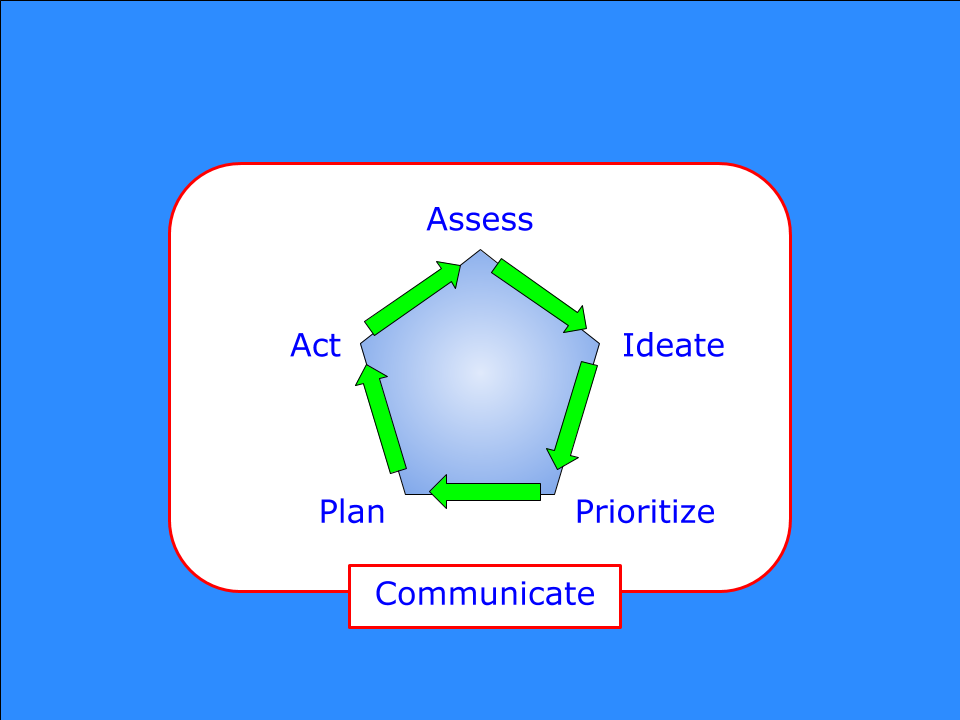
Objective and Outputs of Ideate
The objective of the Ideate phase is to identify ideas for future actions that can address the Assessment Topic. The opportunities identified during the SWOT analysis will be the starting point. We’ll use the other outputs of the SWOT analysis to further develop the action ideas by looking for ways to build on strengths, shore up weaknesses and mitigate the risks inherent in the threats.
There are three outputs from the Ideate process:
- An “Idea Map” for each opportunity. The Idea Map will illustrate each action, and how the strengths weaknesses and threats either facilitate it or constrain it.
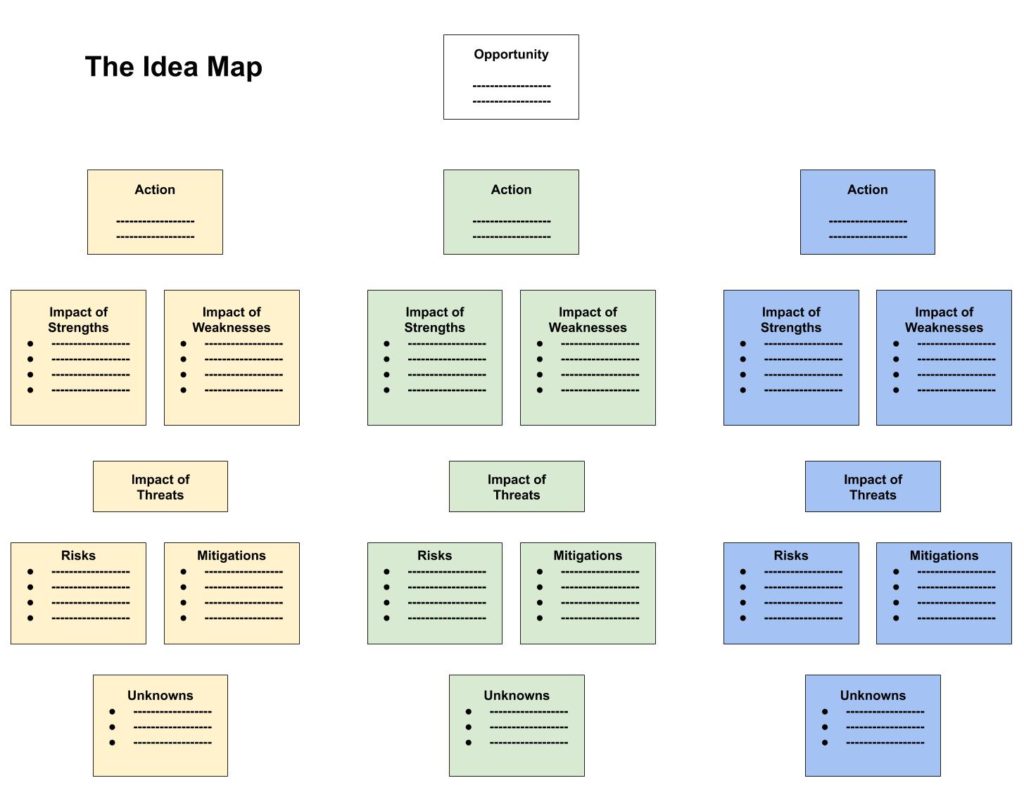
- One page summaries of each proposed action. These will be inputs for the Prioritize and Plan activities that follow. They will also be useful tools for the Communicate activity.
- A list of “how to do it” suggestions for each action. Our focus during Ideate is to identify possible actions, but it is likely that members of the team will make suggestions about how an action could be implemented. We’ll capture those for consideration during the Plan activity later in the cycle.
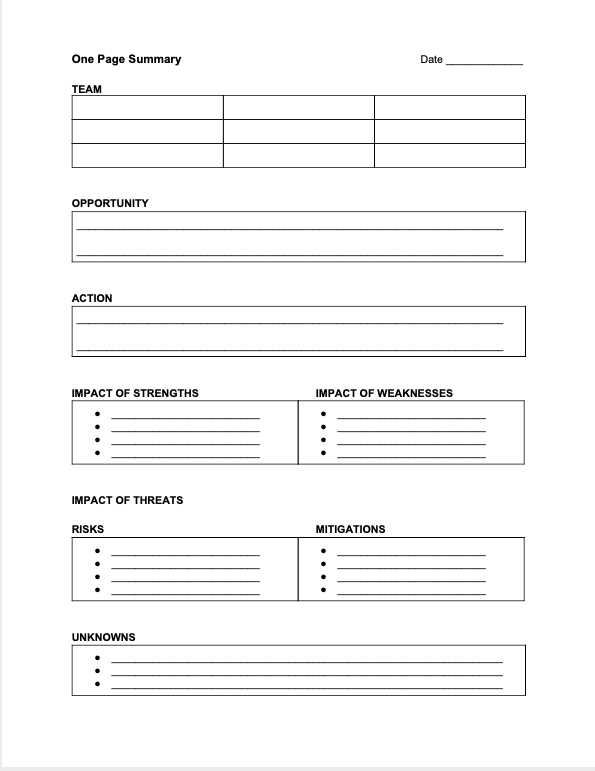
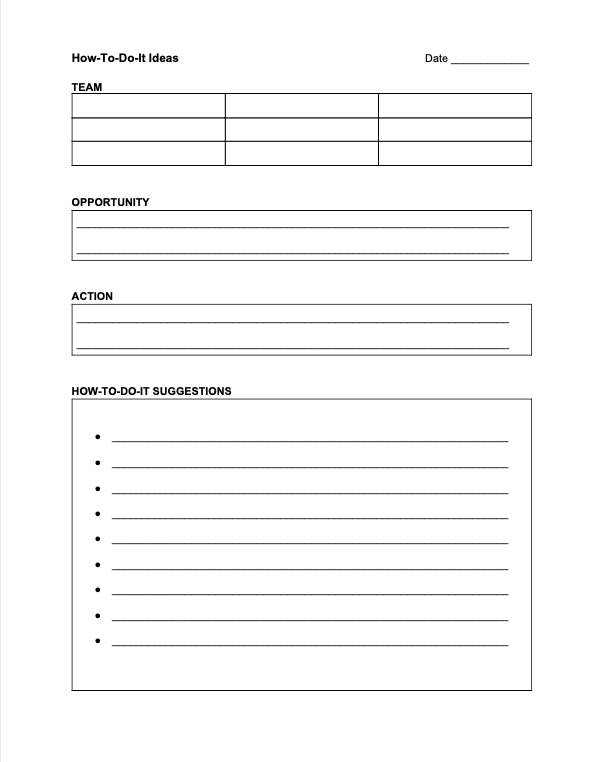
I’ve created free downloadable templates for each of the Ideate outputs.
Logistics
The Ideate Team. Ideally, the Ideate process should be performed by the same team that you assembled for the Assess activity. That group will be familiar with the outputs and should represent a broad set of opinions and backgrounds. If new team members are added, you should arrange a time to brief them on the process and outputs of the Assess phase.
Approach. We’ll use an approach similar to the one used during Assess. At each step we will be asking and answering questions and capturing the responses. We will not attempt to solve the problem or specify exactly how each action could be implemented. Any thoughts about “how to do it” will be captured for use later in the planning cycle.
Preparation. To prepare for the Ideate phase, there are several tasks that you, as the sponsor or leader, should complete. These are:
- Publish the SWOT analysis output from the Assess phase to the team. This will allow them to refresh their memories prior to beginning the Ideate process.
- Create an Idea Map template. This could be a large poster on the wall (if you’re meeting in person) or a template in PowerPoint or Visio (if the team is meeting online). The downloadable template is a PowerPoint file that could be blown up to poster size for an in-person meeting or edited online.
- Create a template for One Page Summaries. This could be a Word or PowerPoint document. The downloadable template is a Word document.
- Create a document to capture the How-To-Do-Its. This could be a flip chart page for an in-person meeting or a Word document. The downloadable template is a Word document.
- Enlist the help of an assistant or colleague who can take notes and update documents. Having this help will be critical if you will conduct the Ideate meetings online, but will also be useful if you’re meeting in person. This frees you to concentrate on the discussion.
The Ideate Process
There are there are six steps in the Ideate process:
- Identify future actions
- Refine the list
- Test ideas against Strengths and Weaknesses
- Identify the impact of Threats
- Define the Communications agenda
- Create the One Page Summaries
We’ll go through them one at a time.
Identify Future Actions
The first step is structured brainstorming. The goal is to identify several possible actions that could be taken to address each opportunity.
Review each Opportunity in turn. Begin by making certain that the team has a common understanding of the opportunity statement.
Then generate some discussion and ideas by asking “What actions could we take to address this opportunity?” Encourage the team to think creatively and not be constrained by feasibility concerns. Get the ideas out. We’ll screen them later.
Capture the ideas from each team member. If working in person, get ideas up on the wall, preferably using sticky notes that can be rearranged later.
Refine the List
The second step is to refine the list of possible actions. As we did in Assess, we want to consolidate ideas together, eliminate duplicates, and then refine and restate each action statement to make it specific and understandable.
Depending on the number of actions identified, you may need to do a prioritization exercise to narrow the choices. Alternately, you could split the team into smaller groups and have each group work on a subset of the actions.
During the discussion you will probably identify some things that may be relevant, but about which you don’t know enough . These “unknowns” are items that need to be researched further or analyzed in more detail. We will not take time during this activity to do that research or analysis. But at a later point in the planning cycle, these will be questions that we’ll devote time to answering. Capture them in the “Unknowns” section of the Idea Map. Write out complete thoughts with enough detail to remind you of the topic when you look at it later.
Test against Strengths and Weaknesses
Next we will look at the Strengths and Weaknesses identified as most relevant during the SWOT analysis and consider how they influence our ability to take the proposed actions. For each of the actions we will ask two questions:
- First, “How do the strengths we’ve identified help us take this action?”
- Second, “How do the weaknesses we’ve identified limit or constrain our ability to take this action?”
There are several options for how to sequence this step. You could choose to evaluate all strengths across all opportunities, then evaluate weaknesses. Alternately, you could evaluate the strengths and weaknesses against one opportunity at a time.
Capture the answers on the Idea Map. Try to capture complete thoughts instead of shorthand notes. This will help you remember the details when you revisit the map in later activities
As noted above, there will likely be people saying “Well, we could fix that by doing X or Y”. Capture those comments in the How-To-Do-Its list for later use during the Plan phase.
Before moving on, update the Unknowns section with any items that require additional study.
Identify the Impact of Threats
The next step is to look at the Threats that were identified in the SWOT analysis and ask two questions about each one:
- “How could this threat affect our ability to take this action?”
- “What risks does this threat pose?”
Evaluate each risk for each action. The answers to those questions get listed under the “Risks” heading on the Idea Map.
Once the list of Risks has been completed, take some time to consider how they can be mitigated, by asking “What could we do to mitigate this risk?”
As with the “how-to-do-it” ideas, we want to be careful not to get too deep into the weeds trying to solve the problems. But it will be helpful in the Plan stage to have some ideas about risk mitigation.
Before moving on, update the Unknowns section with any items that require additional study.
Develop the Communication Agenda
As noted in the last article, you have a variety of stakeholders – employees, colleagues, your manager, other senior leaders, suppliers and possibly customers – who have different information needs and varying degrees of interest in your work. Different communications are needed for different stakeholder groups. A “one size fits all” approach is not advisable.
Before you complete the Ideate phase, you will want to review and update the communication plan and decide what information will be communicated to each stakeholder group, when it will be communicated, in what format, and by whom.
In an upcoming article, I will go into the details of the Communicate activity, including how to conduct a stakeholder analysis and develop a communication plan. These tools will help you create the agenda for your communications.
Create the One Page Summaries
The last step in the process is to create a written summary of each of the actions and the related content on the Idea Map. These will be used in the Prioritize phase that follows next. The summaries can also be used as part of your Communication agenda.
You could do this step after the larger group is dismissed for the day and have them ready for review by the team at the next meeting. Alternately, your assistant could transcribe the information into the template while the Communication agenda discussion takes place.
Regardless of how it’s done, you should give the team the opportunity to review and comment on the summaries shortly before completing the Ideate phase.
As you close out the Ideate phase, be sure to retain the lists of ideas and other materials generated during the discussion. These materials will be useful for recalling details during later phases in the planning cycle.
If you’ve not already done so, download the free templates for this phase.
Conclusion
Congratulations! You are now 40% through the planning cycle.
By now you have:
- Identified an important Assessment Topic – a problem or issue that you will need to solve in the future or an opportunity that you want to pursue.
- Assessed your current state by doing a detailed SWOT analysis of the Assessment Topic.
- Used the SWOT output to create an Idea Map that captures ideas for actions to address each Opportunity and considers the impact of Strengths, Weaknesses and Threats on your organization’s ability to execute the proposed actions.
- Determined how to communicate with your different stakeholder groups.
In the next article, we will review the proposed actions and prioritize them.
Until then, please let me know if you have questions about the Assess or Ideate phases. You can always reach me by using the Contact Form.
To your success,


What’s on your mind today?
Do you have a management problem or question that I could help answer?
If so, then let’s talk.
Click the button below and use the Contact form to request a complementary 30 minute chat. We’ll work together to identify some actionable ideas just for you.
